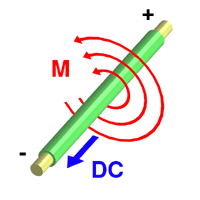Every electron and every proton has an electric charge, thus an electrical field surrounding it. This is a field of force, just like the field of gravitational force we are so familiar with in everyday life. Compared to gravity, however, the electrical force is much stronger. In fact, gravity is a very weak force and is only noticeable because the earth is so huge.
Electrons are never still. When confined to the atom, electrons move constantly creating small magnetic fields. With many electrons, in many atoms, moving in random directions, these small magnetic fields cancel out and we do not notice them. But not always: sometimes the poles of the atom’s magnetic fields become aligned, allowing the magnetic fields to become stronger and more noticeable. There are two basic kinds of magnets: permanent magnets and electromagnets. The permanent magnets are familiar to everyone; most fridges have at least one magnet attaching notes to the door. [1]

Electromagnets have a magnetic field only when an electric current is present. When we pass a current through a wire, a magnetic field is created all around the wire. If we reverse the direction of the current, the orientation of the magnetic field also reverses.
A moving electron creates both electric and magnetic fields. It is therefore better to consider electric and magnetic fields as aspects of a more general type of field, known as the electromagnetic field. When we use this term we are referring to either or both of the electrical field and/or the magnetic field.
There are naturally occurring electromagnetic fields and artificially created ones in our environment. The earth has a very large magnetic field compared to the fields inside our body. The earth’s field arises from many sources; lightening may create an even stronger electromagnetic field, albeit for a very short time. The electrical wires outside your home and inside your home all have their own electromagnetic fields. There are also magnetic fields arising from your fridge magnets and stereo speakers. These household fields are far stronger than the earth’s magnetic field, but are not as pervasive.
The size of the earth’s magnetic field ranges between 0.3 to 0.6 Gauss. [2] Our heart has an electric current regulating it, and it also has an electromagnetic field. The size of our heart’s magnetic field is one million times smaller than the earth’s magnetic field [3] and it too can vary from person to person, and indeed from time to time within the same person. Despite its weakness, the electromagnetic field of the heart is very measurable. Electrocardiograms (ECGs) are used to measure the electrical force at various locations throughout the body. While small, the heart has the largest, but not the only electromagnetic field in our body. Our brain is also a source of electrical activity, so it too has a measurable field. The brain’s magnetic field is around a thousand times weaker [4] than the heart’s and naturally was not detected until long after the heart’s field was discovered.
As we have just seen, any electrons that are in motion will give rise to an electromagnetic field. What about those tiny piezoelectric fields we were discussing in the previous section? Do they too create tiny electromagnetic fields and, if so, can they be measured? The answer is yes. These tiny fields, while too small to be detected until recently, do exist and their associated electromagnetic fields have been measured, thanks to the invention of a cool-sounding device known as a SQUID. Invented by John Zimmerman in the early 1970s, SQUIDs [5] are devices that allow magnetometers to detect very small electromagnetic fields. Zimmerman and others after him[6] were able to detect an increase in the electromagnetic field of a therapeutic touch practitioner’s hands. The study of these generated electromagnetic fields is called “bio-electromagnetism.”
- — Only certain elements can be used as magnets. The elements include iron, nickel, cobalt, and also the rare earth elements of samarium and neodynium, which is the element most commonly used today in magnets.
- — A Gauss is a unit of magnetism named after a famous mathematician.
- — 10-6 Gauss.
- — The brain’s magnetic field is on the order of 10-9 Gauss.
- — SQUIDS stands for Superconducting Quantum Interference Devices.
- — Such as Kusaka Seto of Japan.
(Next: Bio-electromagnetism )
